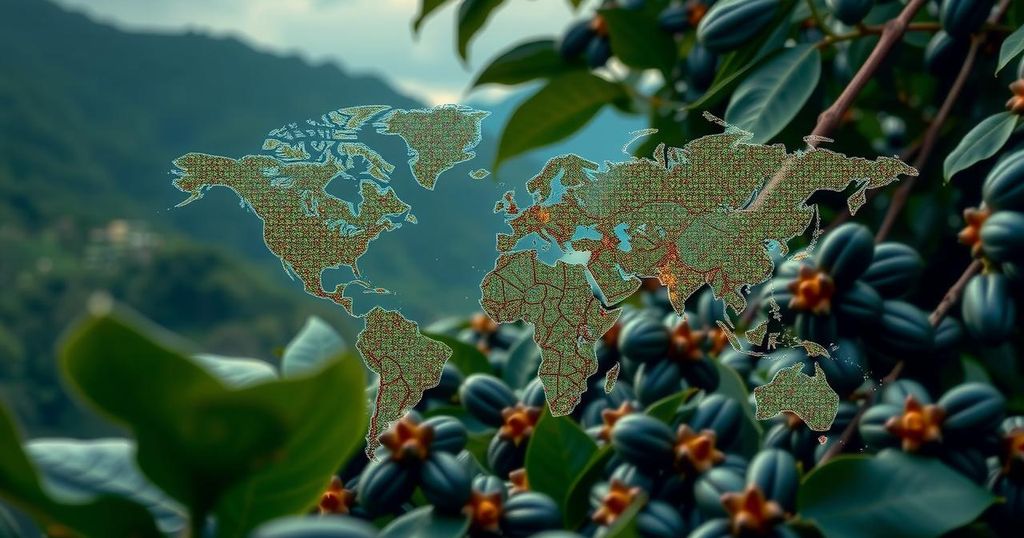The Relationship Between Climate Change, Cocoa Production, and Chocolate Prices

Climate change is adversely impacting cacao tree health, resulting in higher chocolate prices and necessitating sustainable cocoa initiatives in the U.S. and Europe. Rising temperatures and increased humidity have exacerbated pest problems and crop diseases, thus leading to a steep rise in cocoa prices. In response, stakeholders are implementing sustainability programs aimed at supporting farmers and ensuring cocoa availability.
Climate change is significantly affecting cacao production, leading to a rise in chocolate prices and a call for sustainable cocoa initiatives in the United States and Europe. Increasing temperatures combined with rising humidity are altering the environmental conditions across the tropical regions where cacao trees thrive, spanning 20 degrees above and below the equator. Approximately 90% of the world’s cocoa beans are produced by farmers in countries such as Brazil, Cameroon, Côte d’Ivoire, the Dominican Republic, Ecuador, Ghana, Indonesia, Nigeria, and Peru, totaling around five million tonnes annually. Cacao trees are particularly sensitive to changes in the environment, struggling to yield beans under diverse or extreme climatic conditions. Notably, in Côte d’Ivoire and Ghana, shifts in climate have allowed pest populations, such as mealybugs, to flourish, exacerbating the situation. These pests contribute to the spread of the swollen shoot virus, which has decimated cacao trees—an estimated 200 million have died due to this issue, driving up cocoa bean prices. Concurrently, a fungus known as black pod disease has proliferated due to increased heatwaves and rainfall, further jeopardizing cacao yield. The United Nations Conference on Trade and Development (UNCTAD) recently reported a sharp increase in cocoa futures price, which reached an unprecedented $10,000 per metric tonne. According to UNCTAD, “Extreme weather and changing climate patterns have upended crop harvests, which are expected to fall short for the third year in a row, tightening global supplies and raising prices,” highlighting that cocoa costs surged by 136% from July 2022 to February 2024. In response to the adverse effects of climate change and deforestation, stakeholders in the United States and Europe are increasingly focusing on sustainable cocoa solutions. In 2023, the U.S. Agency for International Development launched a project with the Indonesian government and private sector aimed at training 6,500 cocoa and coffee farmers in sustainable agroforestry practices. This initiative targets regions in East Nusa Tenggara, North Sumatra, and South Sulawesi, where farmers are grappling with reduced tree health and lower yields due to climate stressors. Regarding the broader market, the United States plays a pivotal role in the chocolate industry, importing $3.9 billion and exporting $1.9 billion worth of cocoa and chocolate products in 2023. Canada, Mexico, and Vietnam were the largest markets for American chocolate exports. Concurrently, Europe is similarly engaged in sustainable cocoa efforts, with Germany’s “German Initiative on Sustainable Cocoa” striving for sustainable sourcing, achieving 92.2% of their cocoa products from sustainable sources as of 2023. Switzerland is also promoting sustainable cocoa practices through the Swiss Platform for Sustainable Cocoa, aiming for 80% of imports to be sustainably sourced by 2025. The emphasis on sustainable cocoa practices not only addresses market demand but also seeks to enhance the livelihoods of farmers and their families, contributing positively to their communities through greater agricultural resilience.
The article discusses the impact of climate change on cacao production and its subsequent effects on chocolate prices. It highlights how rising temperatures and humidity disrupt the delicate balance of conditions necessary for cacao trees to thrive. Additionally, it delves into the actions being taken by the United States and European stakeholders to promote sustainable cocoa farming amidst the challenges posed by environmental changes.
In conclusion, climate change poses a significant threat to cacao production, leading to rising chocolate prices and prompting urgent calls for sustainable cocoa farming practices. Both the U.S. and European stakeholders are actively engaging in initiatives aimed at enhancing sustainability in cocoa production, which is essential not only for ensuring chocolate’s ongoing availability but also for improving the livelihoods of farmers affected by these environmental challenges.
Original Source: www.forbes.com






